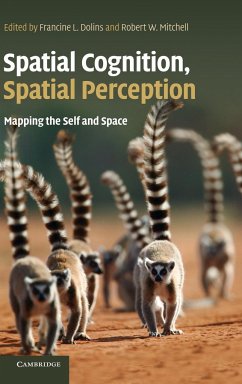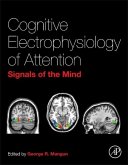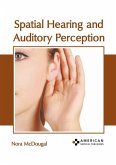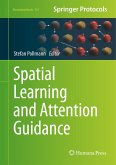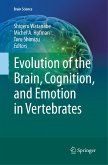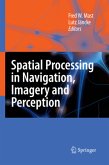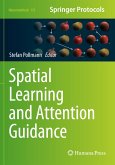Spatial Cognition, Spatial Perception
Herausgeber: Dolins, Francine L.; Mitchell, Robert W.
Spatial Cognition, Spatial Perception
Herausgeber: Dolins, Francine L.; Mitchell, Robert W.
- Gebundenes Buch
- Merkliste
- Auf die Merkliste
- Bewerten Bewerten
- Teilen
- Produkt teilen
- Produkterinnerung
- Produkterinnerung
An analysis of human and non-human animals' spatial cognitive, perceptual, and behavioural processes through mapping internal and external spatial knowledge.
Andere Kunden interessierten sich auch für
![Cognitive Electrophysiology of Attention Cognitive Electrophysiology of Attention]() Cognitive Electrophysiology of Attention108,99 €
Cognitive Electrophysiology of Attention108,99 €![Spatial Hearing and Auditory Perception Spatial Hearing and Auditory Perception]() Spatial Hearing and Auditory Perception156,99 €
Spatial Hearing and Auditory Perception156,99 €![Spatial Learning and Attention Guidance Spatial Learning and Attention Guidance]() Spatial Learning and Attention Guidance147,99 €
Spatial Learning and Attention Guidance147,99 €![Aging: Clinical Perspectives on Spatial Memory and Emotional Perception Aging: Clinical Perspectives on Spatial Memory and Emotional Perception]() Aging: Clinical Perspectives on Spatial Memory and Emotional Perception170,99 €
Aging: Clinical Perspectives on Spatial Memory and Emotional Perception170,99 €![Evolution of the Brain, Cognition, and Emotion in Vertebrates Evolution of the Brain, Cognition, and Emotion in Vertebrates]() Evolution of the Brain, Cognition, and Emotion in Vertebrates132,99 €
Evolution of the Brain, Cognition, and Emotion in Vertebrates132,99 €![Spatial Processing in Navigation, Imagery and Perception Spatial Processing in Navigation, Imagery and Perception]() Spatial Processing in Navigation, Imagery and Perception110,99 €
Spatial Processing in Navigation, Imagery and Perception110,99 €![Spatial Learning and Attention Guidance Spatial Learning and Attention Guidance]() Spatial Learning and Attention Guidance95,99 €
Spatial Learning and Attention Guidance95,99 €-
-
-
An analysis of human and non-human animals' spatial cognitive, perceptual, and behavioural processes through mapping internal and external spatial knowledge.
Hinweis: Dieser Artikel kann nur an eine deutsche Lieferadresse ausgeliefert werden.
Hinweis: Dieser Artikel kann nur an eine deutsche Lieferadresse ausgeliefert werden.
Produktdetails
- Produktdetails
- Verlag: Cambridge University Press
- Seitenzahl: 606
- Erscheinungstermin: 13. März 2014
- Englisch
- Abmessung: 235mm x 157mm x 37mm
- Gewicht: 1016g
- ISBN-13: 9780521845052
- ISBN-10: 052184505X
- Artikelnr.: 30207410
- Herstellerkennzeichnung
- Books on Demand GmbH
- In de Tarpen 42
- 22848 Norderstedt
- info@bod.de
- 040 53433511
- Verlag: Cambridge University Press
- Seitenzahl: 606
- Erscheinungstermin: 13. März 2014
- Englisch
- Abmessung: 235mm x 157mm x 37mm
- Gewicht: 1016g
- ISBN-13: 9780521845052
- ISBN-10: 052184505X
- Artikelnr.: 30207410
- Herstellerkennzeichnung
- Books on Demand GmbH
- In de Tarpen 42
- 22848 Norderstedt
- info@bod.de
- 040 53433511
Introduction 1. Linking spatial cognition and spatial perception F. L.
Dolins and R. W. Mitchell; Part I. What Do Animals Know and How Do They
Represent External Space?: 2. Psychology and the philosophy of spatial
perception: a history, or how the idea of spatial cognition in animals
developed R. W. Mitchell and F. L. Dolins; 3. Common principles shared by
spatial and other kinds of cognition K. Cheng; 4. To be buried in thought,
lost in space or lost in action: is that the question? E. Menzel; Part II.
Perception and Memory of Landmarks: Implications for Spatial Behaviour and
Cognition: 5. The encoding of geometry in various vertebrate species C.
Thinus-Blanc, V. Chabanne, L. Tommasi, P. Peruch and J. Vauclair; 6. The
visually guided routes of ants T. Collett and P. Graham; 7. The role of
landmarks in small and large scale navigation S. D. Healy and V. A.
Braithwaite; 8. Examining spatial cognitive strategies in small-scale and
large-scale space in tamarin monkeys P. A. Garber and F. L. Dolins; 9.
Spatial learning and foraging in macaques C. Menzel; Part III. Evolutionary
Perspectives of Cognitive Capacities in Spatial Perception and Object
Recognition: 10. The evolution of human spatial cognition T. Wynn; 11.
Egocentric and allocentric spatial learning in the nonhuman primate L.
Rehbein, S. Schettler, R. Killiany and M. Moss; 12. Does the nature of
cetacean perception make understanding object permanence unnecessary? R. W.
Mitchell and E. Hoban; 13. Multimodal sensory integration and concurrent
navigation strategies for spatial cognition in real and artificial
organisms A. Arleo and L. Ronde-Reig; Part IV. Does Mapping of the Body
Generate Understanding of External Space?: 14. Movement: the generative
source of spatial perception and cognition M. Sheets-Johnstone; 15.
Understanding the body: spatial perception and spatial cognition R. W.
Mitchell; 16. The evolution of parietal areas involved in hand use in
primates L. Krubitzer and E. Disbrow; 17. Body mapping and spatial
transformations S. H. Creem-Regehr; 18. Understanding of external space
generated by bodily re-mapping: an insight from the neurophysiology of
tool-using monkeys A. Iriki; 19. Left-right spatial discrimination and the
evolution of hemispheric specialization: some new thoughts on some old
ideas W. D. Hopkins and C. Cantalupo; Part V. Comparisons of Human and
Non-Human Primate Spatial Cognitive Abilities: 20. The geographical
imagination R. Sambrook and D. Zurick; 21. Of chimps and children: use of
spatial symbols by two species J. DeLoache and M. Bloom; 22. Chimpanzee
spatial skills: a model for human performance on scale model tasks? S. Till
Boysen and K. A. Bard; 23. The development of place learning in comparative
perspective A. Learmonth and N. Newcombe; 24. Spatial cognition and memory
in symbol-competent chimpanzees C. Menzel.
Dolins and R. W. Mitchell; Part I. What Do Animals Know and How Do They
Represent External Space?: 2. Psychology and the philosophy of spatial
perception: a history, or how the idea of spatial cognition in animals
developed R. W. Mitchell and F. L. Dolins; 3. Common principles shared by
spatial and other kinds of cognition K. Cheng; 4. To be buried in thought,
lost in space or lost in action: is that the question? E. Menzel; Part II.
Perception and Memory of Landmarks: Implications for Spatial Behaviour and
Cognition: 5. The encoding of geometry in various vertebrate species C.
Thinus-Blanc, V. Chabanne, L. Tommasi, P. Peruch and J. Vauclair; 6. The
visually guided routes of ants T. Collett and P. Graham; 7. The role of
landmarks in small and large scale navigation S. D. Healy and V. A.
Braithwaite; 8. Examining spatial cognitive strategies in small-scale and
large-scale space in tamarin monkeys P. A. Garber and F. L. Dolins; 9.
Spatial learning and foraging in macaques C. Menzel; Part III. Evolutionary
Perspectives of Cognitive Capacities in Spatial Perception and Object
Recognition: 10. The evolution of human spatial cognition T. Wynn; 11.
Egocentric and allocentric spatial learning in the nonhuman primate L.
Rehbein, S. Schettler, R. Killiany and M. Moss; 12. Does the nature of
cetacean perception make understanding object permanence unnecessary? R. W.
Mitchell and E. Hoban; 13. Multimodal sensory integration and concurrent
navigation strategies for spatial cognition in real and artificial
organisms A. Arleo and L. Ronde-Reig; Part IV. Does Mapping of the Body
Generate Understanding of External Space?: 14. Movement: the generative
source of spatial perception and cognition M. Sheets-Johnstone; 15.
Understanding the body: spatial perception and spatial cognition R. W.
Mitchell; 16. The evolution of parietal areas involved in hand use in
primates L. Krubitzer and E. Disbrow; 17. Body mapping and spatial
transformations S. H. Creem-Regehr; 18. Understanding of external space
generated by bodily re-mapping: an insight from the neurophysiology of
tool-using monkeys A. Iriki; 19. Left-right spatial discrimination and the
evolution of hemispheric specialization: some new thoughts on some old
ideas W. D. Hopkins and C. Cantalupo; Part V. Comparisons of Human and
Non-Human Primate Spatial Cognitive Abilities: 20. The geographical
imagination R. Sambrook and D. Zurick; 21. Of chimps and children: use of
spatial symbols by two species J. DeLoache and M. Bloom; 22. Chimpanzee
spatial skills: a model for human performance on scale model tasks? S. Till
Boysen and K. A. Bard; 23. The development of place learning in comparative
perspective A. Learmonth and N. Newcombe; 24. Spatial cognition and memory
in symbol-competent chimpanzees C. Menzel.
Introduction 1. Linking spatial cognition and spatial perception F. L.
Dolins and R. W. Mitchell; Part I. What Do Animals Know and How Do They
Represent External Space?: 2. Psychology and the philosophy of spatial
perception: a history, or how the idea of spatial cognition in animals
developed R. W. Mitchell and F. L. Dolins; 3. Common principles shared by
spatial and other kinds of cognition K. Cheng; 4. To be buried in thought,
lost in space or lost in action: is that the question? E. Menzel; Part II.
Perception and Memory of Landmarks: Implications for Spatial Behaviour and
Cognition: 5. The encoding of geometry in various vertebrate species C.
Thinus-Blanc, V. Chabanne, L. Tommasi, P. Peruch and J. Vauclair; 6. The
visually guided routes of ants T. Collett and P. Graham; 7. The role of
landmarks in small and large scale navigation S. D. Healy and V. A.
Braithwaite; 8. Examining spatial cognitive strategies in small-scale and
large-scale space in tamarin monkeys P. A. Garber and F. L. Dolins; 9.
Spatial learning and foraging in macaques C. Menzel; Part III. Evolutionary
Perspectives of Cognitive Capacities in Spatial Perception and Object
Recognition: 10. The evolution of human spatial cognition T. Wynn; 11.
Egocentric and allocentric spatial learning in the nonhuman primate L.
Rehbein, S. Schettler, R. Killiany and M. Moss; 12. Does the nature of
cetacean perception make understanding object permanence unnecessary? R. W.
Mitchell and E. Hoban; 13. Multimodal sensory integration and concurrent
navigation strategies for spatial cognition in real and artificial
organisms A. Arleo and L. Ronde-Reig; Part IV. Does Mapping of the Body
Generate Understanding of External Space?: 14. Movement: the generative
source of spatial perception and cognition M. Sheets-Johnstone; 15.
Understanding the body: spatial perception and spatial cognition R. W.
Mitchell; 16. The evolution of parietal areas involved in hand use in
primates L. Krubitzer and E. Disbrow; 17. Body mapping and spatial
transformations S. H. Creem-Regehr; 18. Understanding of external space
generated by bodily re-mapping: an insight from the neurophysiology of
tool-using monkeys A. Iriki; 19. Left-right spatial discrimination and the
evolution of hemispheric specialization: some new thoughts on some old
ideas W. D. Hopkins and C. Cantalupo; Part V. Comparisons of Human and
Non-Human Primate Spatial Cognitive Abilities: 20. The geographical
imagination R. Sambrook and D. Zurick; 21. Of chimps and children: use of
spatial symbols by two species J. DeLoache and M. Bloom; 22. Chimpanzee
spatial skills: a model for human performance on scale model tasks? S. Till
Boysen and K. A. Bard; 23. The development of place learning in comparative
perspective A. Learmonth and N. Newcombe; 24. Spatial cognition and memory
in symbol-competent chimpanzees C. Menzel.
Dolins and R. W. Mitchell; Part I. What Do Animals Know and How Do They
Represent External Space?: 2. Psychology and the philosophy of spatial
perception: a history, or how the idea of spatial cognition in animals
developed R. W. Mitchell and F. L. Dolins; 3. Common principles shared by
spatial and other kinds of cognition K. Cheng; 4. To be buried in thought,
lost in space or lost in action: is that the question? E. Menzel; Part II.
Perception and Memory of Landmarks: Implications for Spatial Behaviour and
Cognition: 5. The encoding of geometry in various vertebrate species C.
Thinus-Blanc, V. Chabanne, L. Tommasi, P. Peruch and J. Vauclair; 6. The
visually guided routes of ants T. Collett and P. Graham; 7. The role of
landmarks in small and large scale navigation S. D. Healy and V. A.
Braithwaite; 8. Examining spatial cognitive strategies in small-scale and
large-scale space in tamarin monkeys P. A. Garber and F. L. Dolins; 9.
Spatial learning and foraging in macaques C. Menzel; Part III. Evolutionary
Perspectives of Cognitive Capacities in Spatial Perception and Object
Recognition: 10. The evolution of human spatial cognition T. Wynn; 11.
Egocentric and allocentric spatial learning in the nonhuman primate L.
Rehbein, S. Schettler, R. Killiany and M. Moss; 12. Does the nature of
cetacean perception make understanding object permanence unnecessary? R. W.
Mitchell and E. Hoban; 13. Multimodal sensory integration and concurrent
navigation strategies for spatial cognition in real and artificial
organisms A. Arleo and L. Ronde-Reig; Part IV. Does Mapping of the Body
Generate Understanding of External Space?: 14. Movement: the generative
source of spatial perception and cognition M. Sheets-Johnstone; 15.
Understanding the body: spatial perception and spatial cognition R. W.
Mitchell; 16. The evolution of parietal areas involved in hand use in
primates L. Krubitzer and E. Disbrow; 17. Body mapping and spatial
transformations S. H. Creem-Regehr; 18. Understanding of external space
generated by bodily re-mapping: an insight from the neurophysiology of
tool-using monkeys A. Iriki; 19. Left-right spatial discrimination and the
evolution of hemispheric specialization: some new thoughts on some old
ideas W. D. Hopkins and C. Cantalupo; Part V. Comparisons of Human and
Non-Human Primate Spatial Cognitive Abilities: 20. The geographical
imagination R. Sambrook and D. Zurick; 21. Of chimps and children: use of
spatial symbols by two species J. DeLoache and M. Bloom; 22. Chimpanzee
spatial skills: a model for human performance on scale model tasks? S. Till
Boysen and K. A. Bard; 23. The development of place learning in comparative
perspective A. Learmonth and N. Newcombe; 24. Spatial cognition and memory
in symbol-competent chimpanzees C. Menzel.

